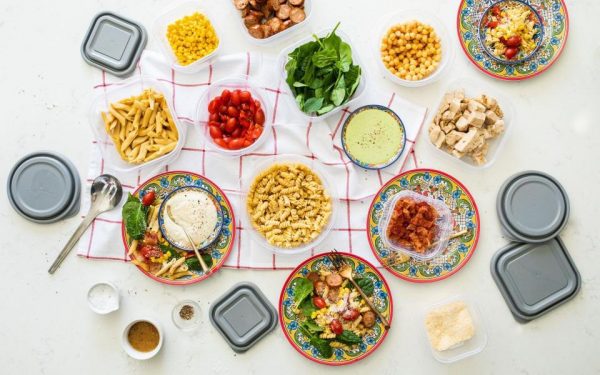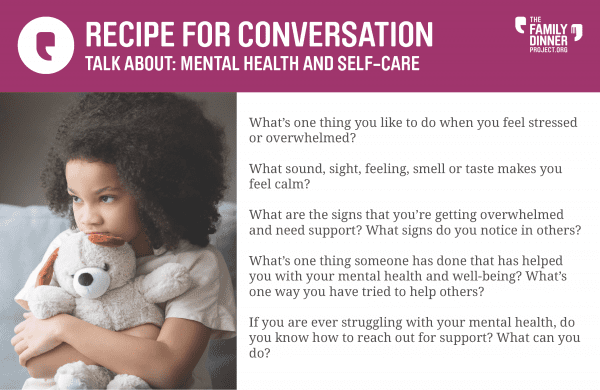Newsletter: April 2023
Reduce Eating Disorder Risk at Family Dinner

One of the research-backed benefits of regular family meals is a reduction in the risk of eating disorders. There are several good theories about why eating together might help protect kids and teens from developing eating disorders; for one thing, structured, regular meals are a daily opportunity for parents to offer nutritious options and keep an eye on any changes in eating habits. Shared meals are also a chance to bond and build resilience and a sense of belonging in kids, which can lead to better mental health outcomes across the board. And eating together means parents can model positive attitudes about food, nutrition, and body image.
But as most adults can tell you, those things are easier said than done. I’ve rarely met anyone over the age of 20 who doesn’t have at least a few stories to share about how diet culture ideals, “thinspiration,” fitness talk, calorie counting, or body image woes showed up at the family dinner table when they were young. My own mother was on and off diets for most of my childhood, cycling between pre-packaged microwave meals and shakes and calorie-controlled low-fat recipes with ingredients like spray-on butter substitute. She’d announce how many calories were in the meal she’d prepared as if calories were like a golf score – the fewer points, the better – and offer to exercise with me to “run off” the food. We did the Cabbage Soup Diet together when I was in junior high school, ate plain iceberg salads topped with water-packed tuna (no mayo or dressing) for “healthy lunches,” and devoted ourselves to Snackwell’s fat-free cookies for “treats.”
I’ll just say that Mom was doing her very best at the time, and that I – like many of the women I know – have had a long road to unlearning a lot of those messages. Now I’m part of a generation of parents who know we need to do better with the way we model a positive relationship to food and eating. Despite our best intentions, eating disorders in kids and teens are on the rise, especially since the pandemic. At the same time, social media and other factors allow our kids to be bombarded with constant messaging about “wellness,” body image, and unattainable filtered perfection. Protective factors like family dinner couldn’t be more important; but how can we make sure the dinner table is actually helping solve the problem, not accidentally contributing to it?
We’ve turned to experts in the field to help us learn more about creating family dinner environments that are truly safe, supportive, and nurturing of positive relationships to food. Dr. Stephanie Harshman offers her insights on raising a family with positive body image, while Dr. Jennifer Goetz and Parent Mentor Oona Hanson share their expertise on what parents need to know about eating disorders and family dinner – red flags, do’s and don’ts, and what the mealtime environment can look like both before and after an eating disorder diagnosis.
Like most of the benefits family meals have to offer, reducing eating disorder risk is most likely to happen when dinner is positive, enjoyable, and free of pressure. I hope every parent takes the time to check out the advice our panel of experts has shared, so we can continue working to create the kind of family dinners that will improve kids’ mental and physical health.
Food

Spring is here, and with it, more possibilities for dinner on the go! Keep everyone fueled and enjoying a wide variety of choices with menus like this Build Your Own Pasta Picnic.
Fun

Keep things positive at family meals with a sweet game like 20 Things I Love About…
Conversation

From time to time, it’s smart to check in with kids and teens about mental health, stress, and self-care. Try these different collections of conversation starters to help you get started.
Talking About: Managing Anxiety
Recent Newsletters
- When Picky Eating Might Be Something More - July 2024
- Feeling Lonely? Share a Meal. - June 2024
- Welcome to May Madness - May 2024
- Family Dinner Has Gotten Expensive - April 2024
- Is it the Family, Or the Dinner? - March 2024
- Black History Month at Family Dinner - February 2024
- New Year, Same You - January 2024
- Sharing the Holiday Load - December 2023
- What’s Your Thanksgiving Story? - November 2023
- Family Dinner: Stressful, or Stress-Busting? - October 2023
- New Ways to Ask “How Was Your Day?” - September 2023
- Low Stress, Low Cost, Low Waste Dinner Hacks - August 2023
